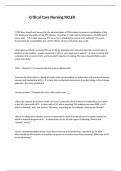Exam (elaborations)
Critical Care Nursing NCLEX
- Course
- Critical Care Nursing NCLEX
- Institution
- Critical Care Nursing NCLEX
F (TPN lines should only be used for the administration of TPN solution to prevent crystalization of the CVC tubing and disruption of the TPN infusion. Any other IV med must be administered via different IV access site) - T/F A client receiving TPN via a CVC is scheduled to receive an IV antibioti...
[Show more]



